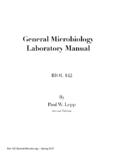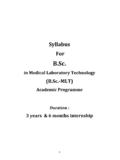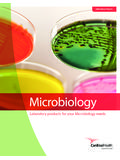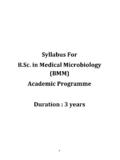Transcription of Commonwealth of Kentucky Wastewater …
1 Commonwealth of Kentucky Wastewater laboratory Certification Manual June 2013 ii This page intentionally left blank iii TABLE OF CONTENTS I. INTRODUCTION I-1 II. general laboratory REQUIREMENTS II-1 Personnel II-1 Changes in Key Personnel II-1 Records II-1 Training Records II-1 Quality Assurance Plan II-2 laboratory Organization and Responsibility II-2 Process Used to Identify Clients Data Quality Objectives II-2 SOPs II-2 Field Sampling Procedures II-3 laboratory Sample Receipt and Handling Procedures II-3 Instrument Calibration Procedures II-3 Analytical Procedures II-4 Data Reduction, Validation, Reporting and Verification II-4 Quality Control Checks and Frequency of Use II-4 List Schedules of Audits and Inter- laboratory Comparisons II-5 Preventive Maintenance Procedures and Schedules II-5 Corrective Action Contingencies II-5 Record Keeping Procedures II-5 Field Sampling and Analysis Procedures II-6 Field Sampling Activities Performed by laboratory Personnel II-6 Field Analysis Activities Performed by the laboratory Personnel II-6 Field Analysis Quality Control II-6 Proficiency Testing Requirements and Frequency II-7 laboratory II-7 laboratory Only Performing Field Analyses II-7 Proficiency Testing Submission II-7 Drinking Water Studies II-8 Proficiency Testing Failure II-8 Proficiency Testing Required for Each Method II-8 Documentation and Record
2 Keeping II-8 Report Requirements and Record Keeping II-8 Legal Defensibility II-8 laboratory Analytical Reports II-9 Maintenance of Records II-9 Sample Records II-9 Analytical Records II-10 Reconstruction of Data II-10 Computer Programs II-10 Sub-contracting II-10 Requirements for Maintaining Certification II-11 Proficiency Test (PT) Samples II-11 iv Methodology II-11 On-site Evaluation II-11 Notification to DOW of Major Changes II-11 Equipment and Supplies II-11 pH Meter II-11 Balance II-12 Temperature Monitoring Device II-13 Refrigerator II-14 Pipets II-14 Glassware and Plasticware II-14 Color Standards II-14 Traceability of Calibration II-15 Quality Assurance / Quality Control II-15 Quality Assurance Plan II-15 Standard Methods Quality Control II-15 Documenting Quality Control II-16 general Methodology Requirements II-16 Sample Management II-16 Data Management II-17 Maintaining Legal Defensibility of Data II-17 III.
3 CRITICAL ELEMENTS FOR CHEMISTRY III-1 Chemistry Methodology III-1 Alternate Test Procedures III-1 Method Modification III-1 laboratory Facility & Safety III-1 laboratory Equipment and Instrumentation III-1 general Chemistry laboratory Practices III-1 general III-2 Inorganic Contaminants III-2 Organic Contaminants III-2 Sample Collection, Handling and Preservation III-2 Rejection of Samples III-3 Sample Containers and Preservation III-3 Maximum Holding Times III-3 Sample Collection and Transport III-3 Sample Collector III-4 Chain of Custody III-4 Sample Compositing III-4 Quality Assurance / Quality Control III-4 Quality Control Acceptance Criteria and Calculations III-4 Demonstration of Capability III-4 Minimum Quality Control and Acceptance Criteria III-7 Quality Control Calculations III-7 Instrument Calibration III-8 Sample Management III-9 Data Management III-9 v IV.
4 CRITICAL ELEMENTS FOR microbiology IV-1 Analytical Methodology IV-1 general IV-1 laboratory Facility IV-3 laboratory Equipment and Supplies IV-3 Temperature Monitoring Device IV-4 Incubator Unit IV-4 Autoclave IV-4 Hot Air Oven IV-5 Conductivity Meter IV-5 Inoculating Equipment IV-6 Membrane Filtration Equipment IV-6 Culture Dishes IV-7 Pipets IV-7 Glassware and Plasticware IV-8 Sample Containers IV-8 Ultraviolet Lamp IV-8 Tray Sealer IV-9 general laboratory Practices IV-9 Sterilization Procedures IV-9 Sample Containers IV-9 Reagent-Grade Water IV-10 Dilution/Rinse Water IV-10 Glassware Washing IV-11 Sample Collection, Handling, and Preservation IV-11 Sampling IV-11 Sample Icing IV-11 Sample Holding/Travel Time IV-12 Quality Assurance IV-12 Proficiency Testing IV-12 Proficiency Testing Required for Each Method IV-12 Records and Data Reporting IV-12 Calculations and Reporting of Results IV-12 Discharge Monitoring Reports and TNTC/CNFG Results IV-12 V.
5 CRITICAL ELEMENTS FOR WHOLE EFFLUENT TOXICITY V-1 Effluent/Receiving Water Sampling & Sample Handling V-1 Introduction V-1 Sample Handling, Preservation and Shipping V-1 Reference Documents V-4 Test Report Requirements V-4 VI. CONTACT INFORMATION VI-1 vi APPENDICES APPENDIX A: Glossary and Acronyms APPENDIX B: Definitions and laboratory Terms APPENDIX C: ASTM Type I, II, III, and IV Water Specifications I-1 I. INTRODUCTION This manual is incorporated by reference in 401 KAR 5:320 and establishes technical procedures and minimum requirements of the Kentucky Wastewater laboratory Certification Program. A copy of this manual may be found on the following website: I-2 This page intentionally left blank II-1 II.
6 general laboratory REQUIREMENTS This section establishes requirements for all laboratories. Information regarding specific disciplines ( , Chemistry, microbiology , and Whole Effluent Toxicity can be found in the appropriate critical elements sections of this manual. All certified Wastewater laboratories are responsible for meeting the requirements specified in this section and any specific discipline section for which they are certified ( Chemistry, microbiology , and Whole Effluent Toxicity. Personnel The laboratory shall have sufficient supervisory, quality assurance and technical staff with the necessary education, training, technical knowledge, and experience for their assigned functions. Changes in Key laboratory Personnel Key laboratory personnel changes (as identified in 401 KAR 5:320) shall be communicated to DOW in writing within 30 days of the change.))
7 Personnel Records Personnel records shall be maintained for laboratory supervisors, consultants, and analyst/technician for a minimum of five (5) years. For the new analyst/technician, academic background and continuing education shall be documented and updated annually, as necessary. A copy of the results of the proficiency test (PT) samples, blind samples, and successful completion of the training courses, where applicable, shall be on file. Training Records Training records shall be maintained by a certified Wastewater laboratory for laboratory personnel for a minimum of five (5) years. These records shall include job-related formal education and training courses taken by the analyst/technician that pertain to his or her responsibilities, including analytical methodology, laboratory safety, sampling, quality assurance, data analysis, etc.
8 Analyst/technician training records shall include all method detection limit (MDL) studies, initial demonstrations of capability (IDC) and on-going demonstration of capability (ODC) summary results and all associated raw data. This information shall be available during an on-site audit or by request by DOW. II-2 Quality Assurance Plan A laboratory analyzing Wastewater compliance samples shall adhere to quality control procedures established in the analytical methods in 40 136. Each laboratory shall prepare, implement, and maintain a written Quality Assurance Plan (QAP). The QAP shall be kept current by conducting an annual review and making necessary revisions. laboratory personnel shall be familiar with the contents of the QAP. If the annual review results in substantive updates or revisions, the amended QAP shall be submitted to the cabinet with the application for renewal of certification.
9 The laboratory QAP shall be a stand-alone document. However, it may reference other documents such as Standard Operating Procedures (SOP), published methods, or other published literature. The following items shall be addressed in the laboratory QAP: laboratory organization and responsibility Include a chart or table showing the laboratory organization and lines of responsibility, including QA managers. List the key individuals who are responsible for ensuring the production of valid measurements and the routine assessment of measurement systems for precision and accuracy ( , who is responsible for internal audits and reviews of the implementation of the plan and its requirements). Reference the job descriptions of the personnel and describe training to keep personnel updated on regulations and methodology, and document that laboratory personnel have demonstrated proficiency for the methods they perform ( MDL Study and IDC).
10 Process used to identify clients data quality objectives (DQO). SOPs with dates of last revision The laboratory shall maintain SOPs that accurately reflect all phases of the current laboratory activities. Keep a list of SOPs and their effective dates. Ensure that current copies of SOPs are in the laboratory and in the QA manager s files. Ensure that SOPs are reviewed annually and revised as changes to the procedure are made. II-3 Ensure that SOPs have signature pages and revision dates. Ensure that SOPs are read, understood, and used by applicable laboratory personnel. Field sampling procedures Describe the process used to identify sample collectors, sampling procedures and locations, required preservatives, proper containers, correct sample container cleaning procedures, sample holding times from collection to analysis, and sample shipping and storage conditions.






